Successful hedges start with determining your sun, soil and water conditions.
A sun-loving hedge is not going to be lush & fully leaved out to the ground if planted in partial shade. It may 'tolerate' partial shade, but don't expect it to look its best.
And even some 'sun-loving' plants, don't necessarily stand up to the harsh Florida sun -- preferring a little partial shade during the worst of the afternoon heat.
While not an exhaustive list, here's a few hedge ideas to start you thinking:
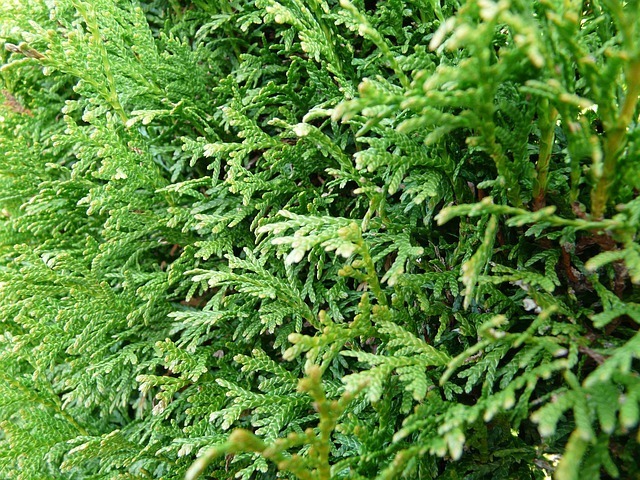
Arborvitae "Green Giant" (Thuja standishii x plicata "Green Giant")
FULL SUN

15g Arbovitea Thuja 'Green Giant' = 5-6' tall average
Thuja 'Green Giant' is deer resistant, and has very little pest or disease issues.
It's sap and oil are used in aromatherapy as well as for a homeopathic burn ointment.
Thuja 'Green Giant'
aka Arborvitae "Green Giant"
Thuja standishii x plicata "Green Giant"
suited for USDA zones 4-9
Thuja 'Green Giant', a member of the Arbovitae family, is a rapid growing evergreen, pyramidal-shaped bush or rather tree, that can make a tidy, dense hedge. It is ideal for a privacy screen or a dust and noise barrier and can be used alone or mixed with other shrubs for an attractive backdrop.
GROWING CONDITIONS
Thuja loves full sun, tolerates partial shade. They perform best in well-draining loamy soil, that is slightly acidic with a pH of 6.5-6.8.
They grow rapidly to approximately 40-60', though can reach as high as 100' in northern grow zones.
Leaf branches are full and lacy, and become a dark luscious green as they age. New growth produces a beautiful mixture of light and dark foliage. They can be left to grow pyramid-shaped, or they can be trimmed and shaped into a flat-topped hedge.
And while we're not huge fans of mulch because of fungi issues it creates, a Thuja hedge is one planting that benefits greatly from mulch around the base of the plants, just not w/in 6-8" of the trunks.
GROWTH RATE
Thuja generally take at least one season to adjust to their new home, and grow more rapidly in the second year, once roots are well established. Growth rate is typically 3 feet per year (after the year of planting), though it can be as much as 5' under ideal conditions.
So if you start with a 7g pot specimen that is typically 3-3.5' tall planted height, expect a full 7-8' privacy hedge in about 3 years: one year to settle in plus 3' of growth for each of the next 2 years. (I'm not counting the top 1-1.5' in the 3rd year, because new growth is typically thin and wispy at the very top.)
WATER
Consistent water, such as from a soaker hose stretched out the length of your hedge, will give you a more dense and luscious looking hedge. They especially need water in the summer months in Florida. Lack of water causes the needles to turn yellow or brown. Too much water causes drooping branching and discoloration.
HISTORICAL
Thuja 'Green Giant' is a cross between Japanese arborvitae (Thuja standishii) and Western Red Cedar (Thuja plicata), developed in 1967. It thrives in USDA zones 4 through 8, though it can grow easily in zone 9 with consistent water and a little organic plant food. There are many propagation nurseries in all of zone 9 Florida growing Thuja!
VIBURNUM AWABUKI:
forms a dense, evergreen hedge; broad leathery but glossy leaf with shiny/waxy, lustre appearance to the leaves;
very durable plants; does best in full sun; tolerates partial shade;
not as fast growing as many other hedge options; grows 6-12' tall, but can be kept trimmed; We used to call it "Emerald Lustre" or "mirrow leaf" viburnum;
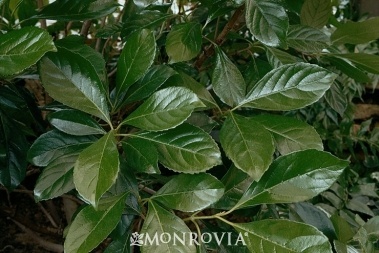
Emerald Lustre Vibernum:
Vibernum Awabuki

Ruby Loropetalum flowers
LOROPETALUM CHINESIS:
There are at least 3 kinds of loropetalum, each useful for a different purpose in the landscape: 'ruby', 'plum' and 'zhuzhou'.
'Ruby' Lorepetalum -- grows up to 6' tall and has brilliant pink blossoms on new growth;
'Plum' Lorepetalum -- prettiest when kept trimmed to 2.5-4' tall; Blossoms on this cultivar are a deep purple.
'Zhuzhou' Lorepetalum:
grows up to 10-12' tall if untrimmed; fast growing; rich pink blossoms on new growth -- nearly the same color tone as the 'ruby' loropetalum; total fertilizer hog; can be shaped into a small tree with multiple trunks and a canopy nearly as wide as it is tall if desired; Also makes an attractive privacy hedge.
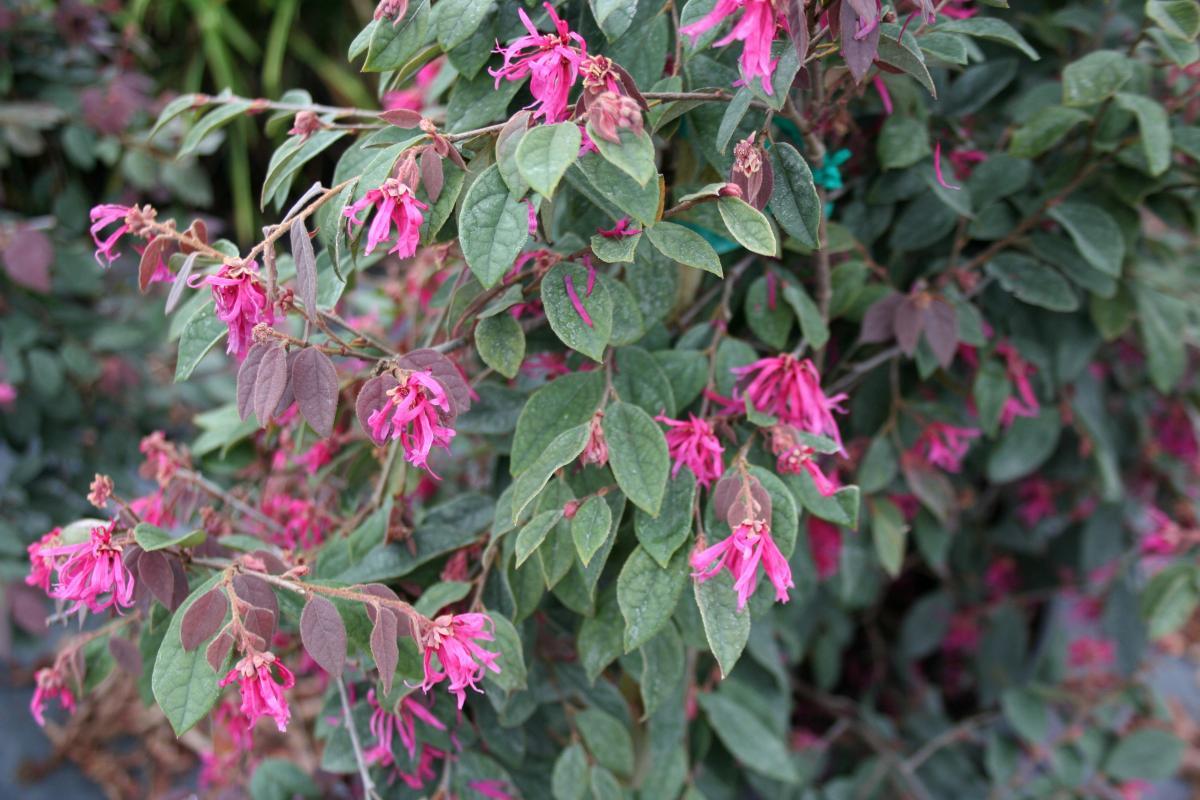
Zhuzhou loropetalum:
at 10-12' tall this is the tallest growing variety
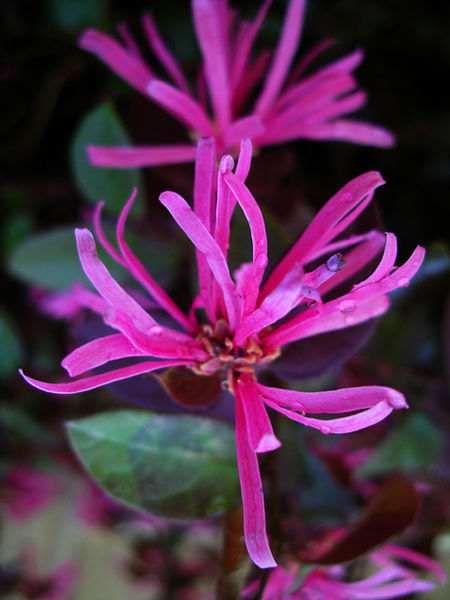
ruby loropetalum up close
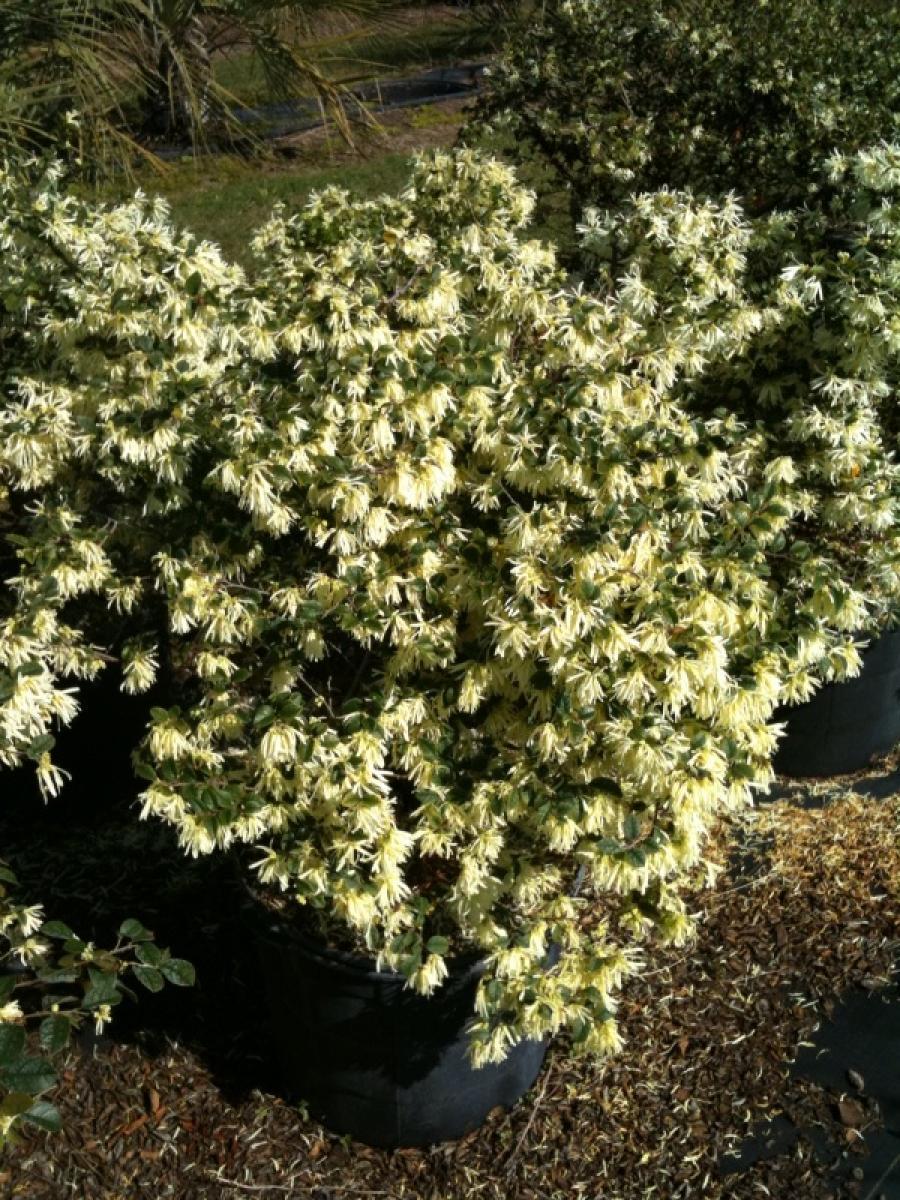
white loropetalum
GARDENIAS:
Gardenias like full sun to partial/filtered sun; and love extra nitrogen -- so heap on the composted chicken manure for best performance.
"Bright shade" is probably a more optimal description of lighting conditions for gardenias. Full sun would be good in the cooler areas of the state such as zone 8b or even 8a, but in 9a or 9b, bright shade is more desirable in the summer heat.
Gardenias are acid-loving plants that grow best in a soil pH of 5.0 to 6.0. If soil pH is higher, you'll need to amend with a little extra iron, because under more alkaline conditions the iron may not be available to the plant, causing yellow leaves.
And don't forget to put a sprinkler hose under the line of plants if you don't have formal irrigation!
Augusta Mystery: grows 5-7' tall at maturity, 4-5' wide;
With dark green evergreen foliage, Augusta Mystery stays pretty all winter and produces fragrant, double white flowers. Hardiest of the gardenia varieties.
Most 1g size are about 12-14" tall; 3g are usually 22"x16".
Augusta Beauty: grows 4-6' tall;
Double Mint: new patented variety -- a bit scarce;
grows 3' tall; produces 2.5-3" flowers;

Double flowering gardenias
Photo courtesy Wikipedia
Aimee: grows 5-6' tall; cultivar of choice when shaping into "standard form", i.e. a single-trunked tree shape. Easiest to find for sale in late March and April.
Most of the other varieties can be found for sale in the cooler months of the year, such as January-March.
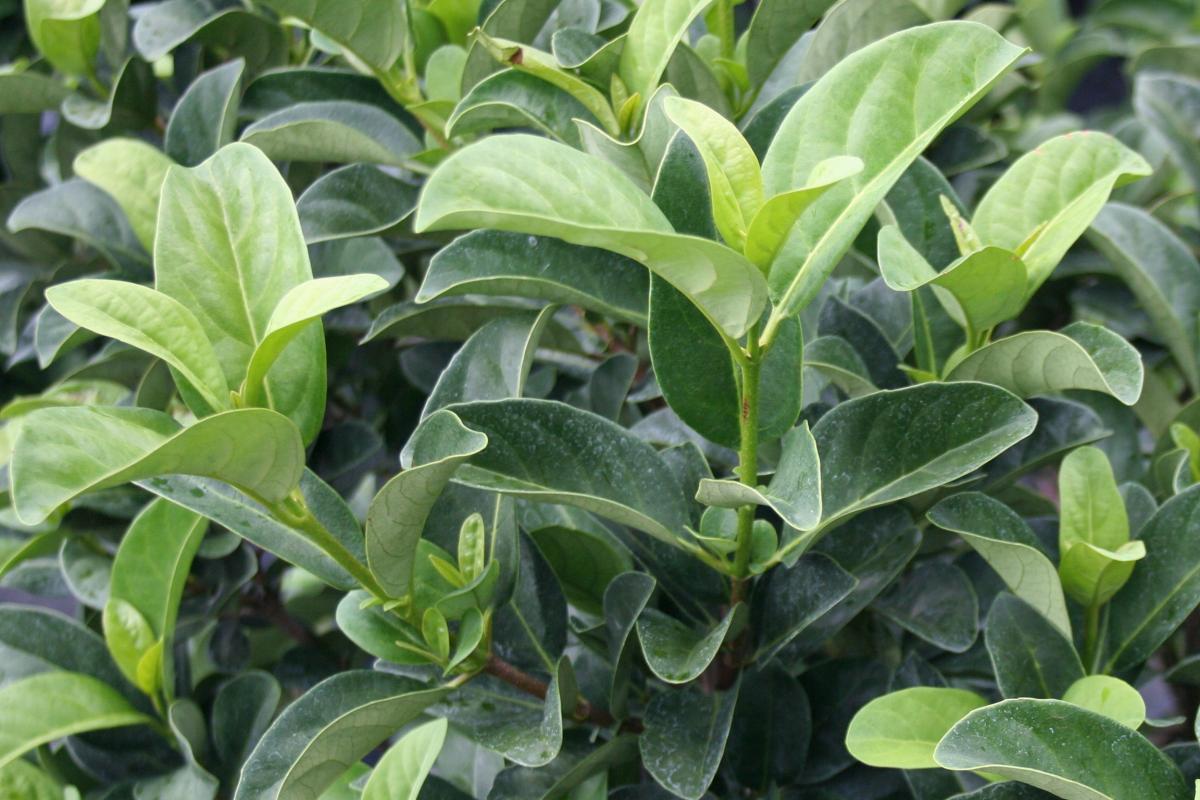
SWEET VIBURNUM
Sweet Viburnum grows 8-15' tall and is an excellent fast-growing evergreen hedge or screening plant.
It has leathery bright green, ovate leaves, and small white fragrant flowers in spring. It's black berries are attractive to birds. Loves full sun, tolerates partial shade.
LEYLAND CYPRESS
Cupressus × leylandii
zones 5-10
Leyland cypress are a popular landscape tree in the South: a vigorous hybrid cross between two Pacific Coast species: the Monterey cypress (Cupressus macrocarpa -- zones 7-10) and the Alaska cedar: Nootka false cypress (Chamaecyparis nootkatensis -- zones 4-8).
Leyland cypress is a rapid growing evergreen, pyramidal-shaped bush or rather tree, that can make a tidy, dense hedge. It is ideal for a privacy screen or a dust and noise barrier.
Just like the Thuja, it prefers full sun, rich loamy soil, slightly acid pH, consistent water until well established, and can be trimmed or not, however the homeowner desires.
DIFFERENCES BETWEEN LEYLAND & THUJA
The first difference to meet the eye is color: Leyland cypress is a dusky blue-green, and Thuja is a mix of light to rich, dark evergreen green.
Both average 60'mature height, though Thuja can grow taller to 100' hgt in colder climates. Both are rapid growing, approximately 3' per year, but Thuja has been known to grow as much as 5' in one year.
Both are pyramidal in shape, but Leyland is thinner and branches are 10-15 wide, whereas Thuja can reach 20' wide. Both respond well to shearing or severe pruning, i.e. shaping into a hedge shape.
Both can thrive in zone 9, but Leyland can ultimately take more heat than Thuja, except for the disease issues. Leyland is slightly more drought tolerant than Thuja in the deep South.
However, Thuja has no significant pests or diseases, while Leyland are increasingly susceptible to new fungi issues, causing significant loss of foliage at the base of the plant. Where privacy is the main objective, the loss of bottom foliage can be problematic.
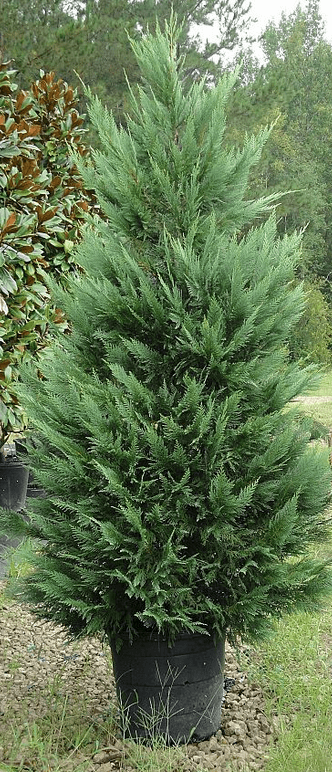
typical 15g Leyland cypress: 5-6' planted height

Pineapple Guava is NOT a member of the guava family of plants: it is neither a pineapple nor a guava. It derives its name from the flavor of the fruit.
PINEAPPLE GUAVA
Acca sellowiana syn : feijoa sellowiana, Myrtacées
The Pineapple Guava makes an interesting edible hedge plant for North and Central Florida. Mature size is 10' tall and 8' wide.
It requires cool temperatures in the 20's to 50's for successful flowering, and blooms in April & May. This drought tolerant plant is an evergreen shrub with leathery green leaves and silvery undersides.
Sweet, edible green fruit with a pear-like texture ripens in the fall: August to October. It has a sweet fragrance even before it is fully ripe. Flavor is something like a cross between pineapple, guava and mint.
Size of fruit varies from small kumquat size to kiwi size, depending on soil and growing conditions. To serve, cut the fruit in half and scoop the pulp out with a spoon. Pineapple Guava is self fertile, but planting two or more increases yields on each plant.
Drought tolerant and can also be grown in pots. Prefers full sun, but grows well in partial shade also. However, more fruit will set if grown in full sun. Prefers slightly acidic soils.
BOTTLEBRUSH
Callistemon
zones 7a-11 (hardy to 0 degrees)
Bottlebrush is an attractive flowering evergreen perennial, that attracts hummingbirds, bees and butterflies.
It has dense foliage, a fast growth habit, and flowers from spring into fall. Plants grow 10-15' tall at maturity.
Bottlebrush prefers full sun to mostly full sun, and well drained moist soil rich in organic matter and nutrients. Pruning is optional, but trimming up to a third of the foliage first thing in the spring will encourage more blooms.
Plants are deer and insect resistant.

Bottlebrush can be shaped into a bush or a tree
Other ideas for edible hedges:
for both zone 9a & 9b, but far denser in 9b:
for zone 9b (takes light frosts to ~30 degrees):
SHADE TO PARTIAL SHADE
AZALEAS:
Azaleas love partial shade -- too much shade means less flowers. Some varieties like Southern Charm & Formosa Red will thrive in full sun IF they are watered daily -- really soaked as in a soaker hose or irrigation.
Both Southern Charm (pictured here) and Formosa Red will mature at about 6' high.
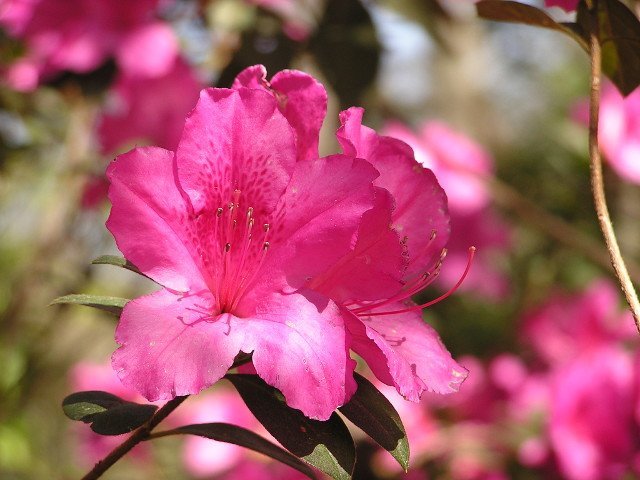
'Southern Charm' azalea
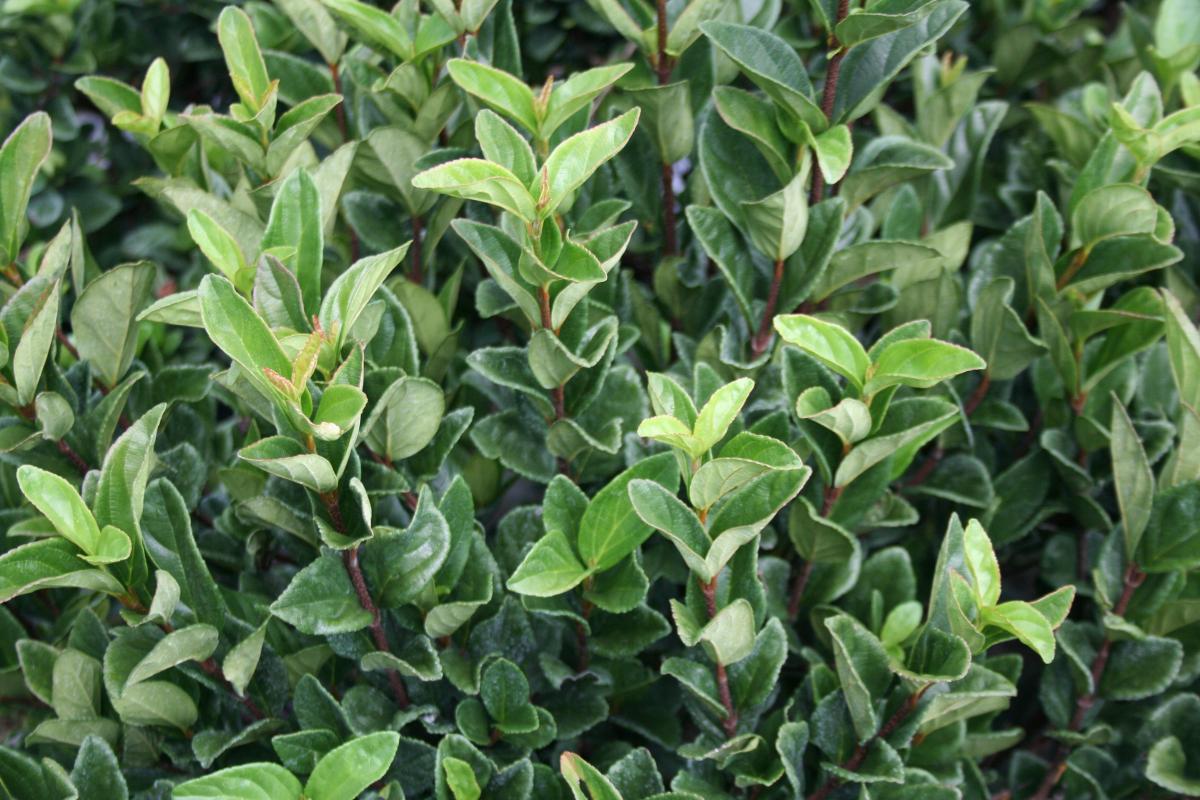
VIBURNUM SUSPENSUM
This viburnum is a native of Okinawa, Japan, and actually does quite well in full shade. Tolerates 'part sun' too.
Likes it moist -- so water well.
Grows 6-12' tall and equally as wide if untrimmed: plant it on 3' centers for a quick hedge.
Much smaller leaf than the viburnum awabuki shown above.
more coming soon !
Indian Hawthorne / boxwood / Photinia 'red tip' / silverthorne eleagnus /
